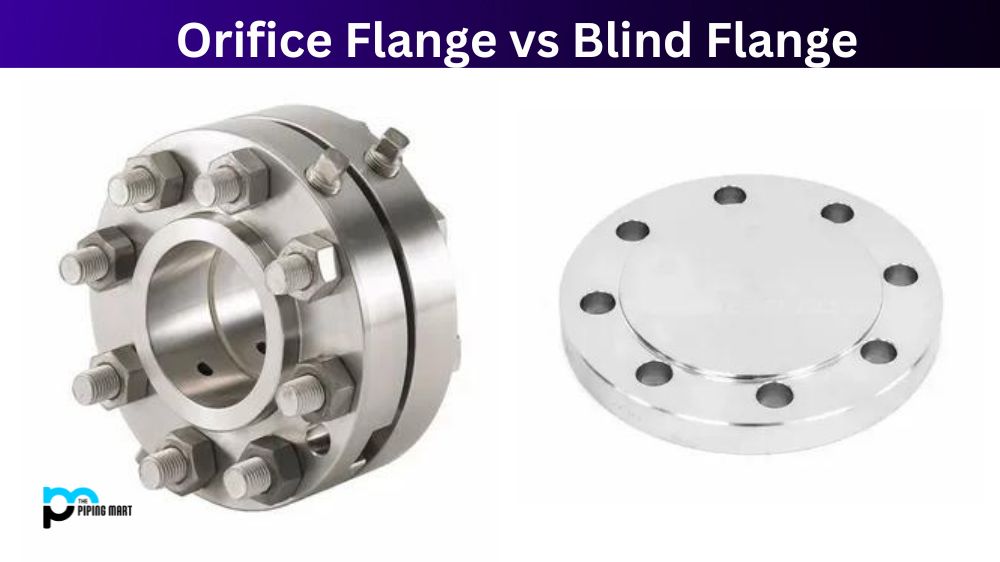When it comes to selecting the right type of flange in a pipeline system, it can be not very clear. Orifice flanges and blind flanges are two common flanges used in industrial applications. While they may look similar at first glance, they serve different purposes. This blog post will explore the key differences between orifice and blind flanges.
What is Orifice Flanges?
Orifice flanges measure and control the flow of liquids or gases in a piping system. They consist of a pipe connected to two flanges with an orifice plate sandwiched between them. The orifice plate has an opening that restricts flow, allowing fluid pressure on one side of the plate while measuring the rate of flow on the other side. This measured pressure differential is then used to calculate a volumetric flow rate, which can be used for calibration, regulation, and control purposes.
What is Blind Flanges?
A Blind Flange is a flange that does not have a bore and is used to terminate the end of piping systems. This flange type can also be used as an access point for welding, inspection and cleaning. It consists of flat face ends, bolts and gaskets generally made from carbon steel, stainless steel or other materials such as nickel alloys. This flange is particularly useful in blocking off lines, equipment or valves when necessary maintenance occurs. Blind Flanges are especially beneficial in applications where a shut-off valve cannot be at the location, and they provide extra support to pipelines operating under high pressures.
Difference Between Orifice Flanges and Blind Flanges
Definition of Orifice Flanges vs Blind Flanges
Before diving into the differences between orifice and blind flanges, let’s define them first. Orifice flanges typically have a small opening or a hole known as the orifice bore, which can control fluids’ flow rate and pressure. On the other hand, blind flanges are used to close the end of a pipe or vessel opening, which means they don’t have any holes or bores.
Application of Orifice Flanges vs Blind Flanges
Orifice flanges are used in pipelines where precise measurement and control of the flow rate and pressure are required. They are also used to measure the fluid flow rate and pressure, even in harsh environments such as high-temperature, high-pressure, and corrosive fluids. Blind flanges, on the other hand, are typically used to close the end of a pipe or vessel connecting to a valve, pump, or pressure vessel. They are also used to isolate or block the pipeline for testing and maintenance purposes.
Material and Design Differences
The material used for orifice flanges tends to differ from blind flanges. Depending on the application and environment, Orifice flanges are typically made of carbon steel, stainless steel, and nickel alloy. They also come in various design options, including raised face, flat face, and ring type joint. Blind flanges, on the other hand, come in two main design types, either with raised or without raised faces. They are typically made of the same materials as orifice flanges.
Cost and Efficiency
Regarding cost, orifice flanges can be more expensive than blind flanges due to their precise measurement and control functions. Blind flanges, on the other hand, are simpler and less expensive to manufacture. However, selecting a flange type depends on the application, environment, and cost-benefit analysis.
Maintenance, Repair, and Replacement
Maintaining, repairing, or replacing orifice flanges can be more complicated than doing so for blind flanges. Orifice flanges require regular maintenance, including inspection and cleaning, to prevent blockages and scaling that can affect the accuracy of the flow measurement. They also require skilled personnel and specialized equipment to repair or replace the orifice plate. Blind flanges, on the other hand, are easier to maintain and can be quickly replaced without affecting the rest of the pipeline system.
Conclusion:
Understanding the key differences between orifice and blind flanges is critical in choosing the right flange type for your pipeline application. Cost, application, material, and maintenance determine which flange type suits your needs. Consulting with a qualified and experienced professional is essential to selecting and installing the right flange for your pipeline system.
Meet Heer, a dynamic and driven writer learning tricks of her trade in the metal industry. With a background in Digital Marketing, Heer brings a unique perspective to her writing, sharing valuable insights. Apart from blogging she like reading and hiking.




